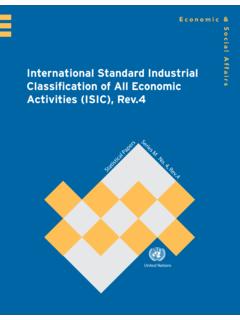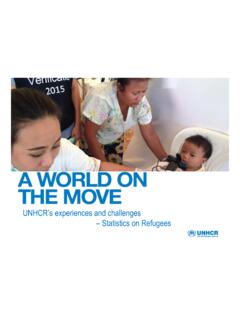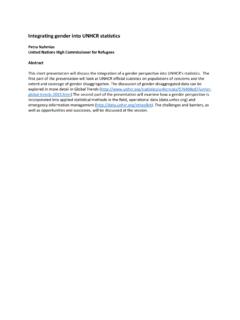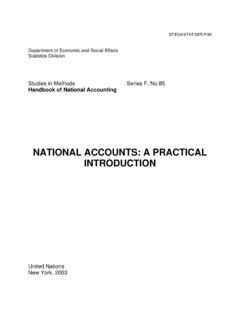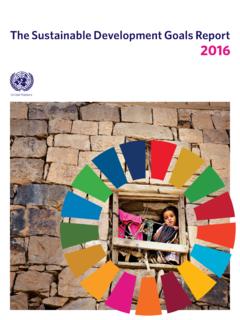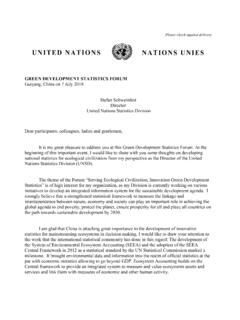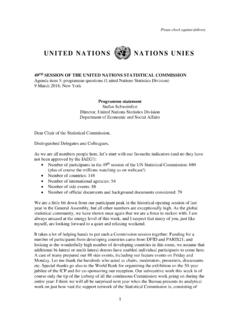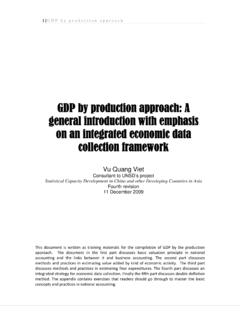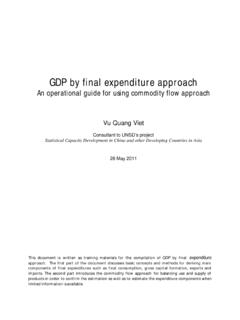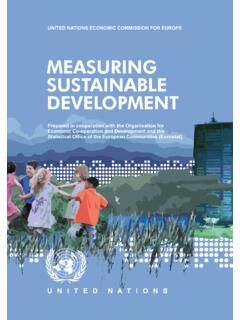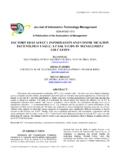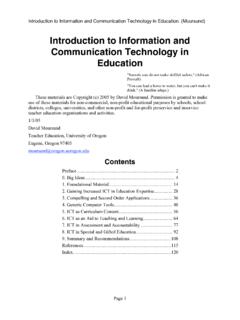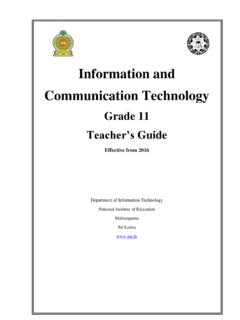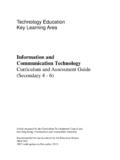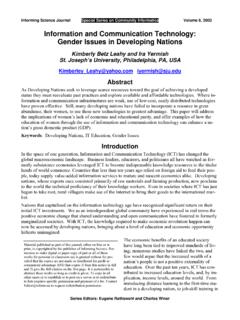Transcription of Information and Communication Technology …
1 Information and Communication Technology statistics in thailand International Seminar on Information and Communication Technology statistics 19 -21 July 2010, Seoul, Republic of Korea Ms. Sureerat Santipaporn Statistician National Statistical Office thailand 1 Contents Page Abstract 2 1. Introduction 3 2. ICT statistics and Policy Making 3 3. The Status of ICT Development in thailand Status of the Development of ICT Human Resources 4 The Status of Information and Communication Technology Infrastructure 10 4. Measuring the Information Society 11 5. Measuring the Information Economy 15 6. Data Limitations 18 7. Conclusion 19 Annexes 20 2 Information and Communication Technology statistics in thailand Abstract thailand has developed ICT under the ICT Master plan.
2 The plan is consistent with the development objectives set forth in the National Economics and Social Development Plan, which is the key national development framework. ICT statistics which were surveyed by the National Statistical Office since 2004 indicated that the readiness of the Information and Communication infrastructure is still not widely available and accessible. This has constrained the efficiency and effectiveness of developing and using ICT for building up knowledge, developing enterprises, and serving the government. In terms of ICT human resources, there has been a continuous expansion alongside the expansion of ICT usage.
3 Presently, thailand has a growing skilled workforce both in the public and private sectors. The number of graduates in related fields at the tertiary and vocational level is also increasing. Nonetheless, there is still a major shortage of ICT human resources, both in term of quantity as well as quality, particularly highly-skilled personnel and specialized personnel in various sub-sectors. For the general public, the usage of ICT is still low and limited in coverage. The majority of the Thai public access Information through traditional media such as television and radio, more so than through computer Technology . The group of ICT user is smaller than other groups, such as those in remote area, the disabled persons and the elderly.
4 In summary, thailand s ICT development and usage has continuously increased. The area which requires further attention is the ICT personnel both in terms of quantity as well as quality, along with the improvement of national ICT governance. Otherwise, these will become obstacle for the development of other activities, since these two issues are fundamental factors for development. 3 1. Introduction Information and Communication Technology (ICT) has rapidly developed. Accordingly, new knowledge and innovation have been created resulting in the continual development in the economy and society. In order to support the change of Information and Communication Technology and telecommunication to develop and promote the ICT capacity of thailand in the global market, the Information and Communication Technology policy (2001 -2010) of thailand or IT 2010 was created to be used as a framework for conducting the 1st thailand Information and Communication Technology Master Plan (2002 2006) and the 2nd thailand Information and Communication Technology Master Plan (2009 2013).
5 The National Statistical Office under the Ministry of Information and Communication Technology has conducted the direct Information and Communication Technology survey since 2001 to support and create policies and plans, as well as to monitor and evaluate the development of Information and Communication Technology from the 1st Information and Communication Technology and the 2nd Information and Communication Technology Master Plan. The survey shows the accessibility of ICT in households, the use of ICT of populations, the use of ICT in establishments and e-Commerce business and the use of ICT in educational institution. 2. ICT statistics and Policy making The IT 2010 framework, and the 1st Information and Communication Technology Master Plan (2002 2006) determined the strategy to develop thailand to become the knowledge and innovation-based society consisting of 5 areas: e-Industry, e-Commerce e-Government e-Education and e-Society.
6 Previously, the 2nd Information and Communication Technology Master Plan (2009-2013) was developed to continue of the policy under IT 2010 framework and also to accelerate and fix the drawbacks that caused the 1st Information and Communication Technology Master Plan to not be able to achieve. The strategies can be described as follows: Strategy 1: Develop ICT professionals and general population to be Information literate The aim of this strategy is to accelerate the development of personnel of adequate quantity and quality to support the development of thailand into a knowledge and innovation-based society. Both ICT professionals as well as personnel in other fields, along with youth, the disadvantaged, the people with disabilities and citizens at all levels should have the knowledge and skills to be Information literate.
7 More specifically, they should have the knowledge and skills to create, produce, and use ICT in an efficient, effective, ethical and considerate manner. Strategy 2: Strengthen National ICT governance This strategy aims to improve mechanisms and processes of ICT management and monitoring to achieve good governance framework by emphasizing on ensuring operational unity, efficient use of resources and participation from all sectors. Strategy 3: Develop ICT infrastructure This strategy aims to develop and manage ICT infrastructure in order to provide universal access to businesses and citizens around the country, including the disadvantaged and people with disabilities. It will encourage businesses to put in place infrastructure that can keep up with technological evolution, in order to meet increasing consumer demand.
8 The infrastructure should support multimedia services, e-Commerce and other services that are useful for modern lifestyles in a knowledge-based society. At the same time, this strategy also focuses on reducing the digital divide which will then lead to a peaceful and happy society where people enjoy a better quality of life. 4 Strategy 4: Use of ICT to support good governance in public administration and services Government agencies should use ICT to improve governance in administration and services. A citizen-centric approach should be adopted to provide services in an efficient, effective, transparent and just manner. Participation from all relevant sectors should be encouraged. Strategy 5: Upgrade competitive capacity of the ICT industry to add value and increase earnings This strategy seeks to upgrade competitiveness of Thai ICT businesses by promoting research, development and innovation by the public sector, academic sector and private sector to upgrade technological capability of the Thai ICT businesses to more upstream Technology .
9 Technology transfer of research outputs to businesses should be encouraged. The businesses environment should also be improved. The priority sectors are software industry and digital content production industry, with the aim to increase the sector s contribution to national economy and earnings. For other industries that have potential, such as the electronics industry (embedded systems or advanced electronic design) and the telecommunications equipment industry, the focus will be on research and development to build upstream capacity. This will allow them to be developed into income generating industries in the future. Strategy 6: Use ICT to build sustainable competitiveness for Thai industries This strategy aims to promote access and use of ICT in the production of goods and services in all sectors to enhance competitiveness by increasing domestic value-added and at the same time being environmentally friendly.
10 This will help prepare businesses to compete under global free trade regimes in the future. Special emphasis will be given to sectors in which thailand has comparative advantage and potential to compete, such as agriculture, health services and tourism. Small and medium enterprises (SMEs) as well as community enterprises will also be targeted for development. 3. The Status of ICT Development in thailand According to the statistics related to the development of ICT human resources, ICT infrastructure, the development of ICT in term of economy and society from the Information of the National Statistical Office, they can be summarized as follows: Status of the Development of ICT Human Resources ICT professionals According to the Labor Force Survey 2009, the total number of ICT employed persons was 416,862 from million persons or The proportion of ICT employed persons increased very slightly from in 2001 to in 2009.
